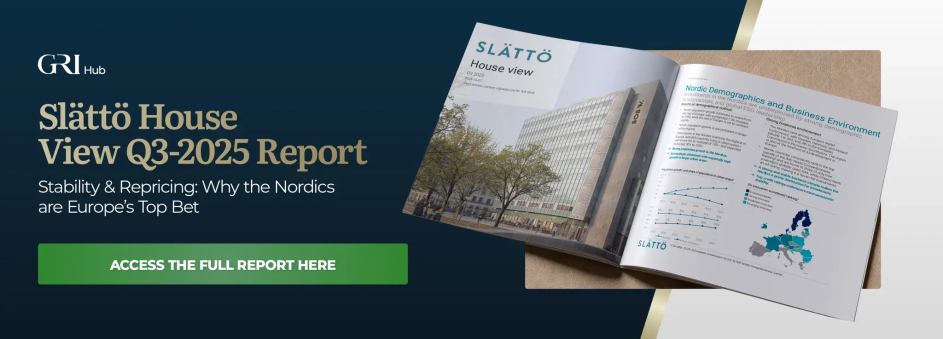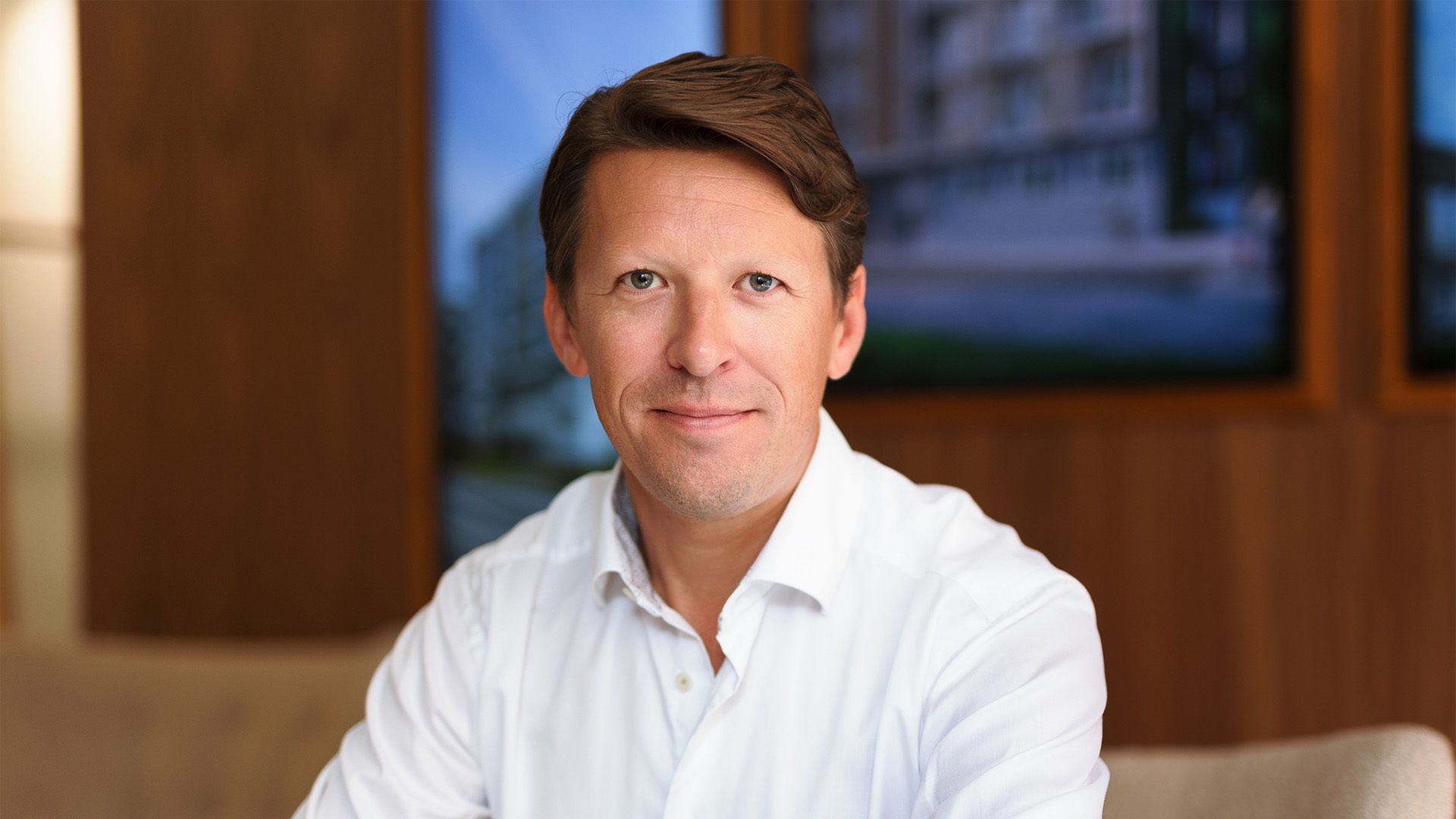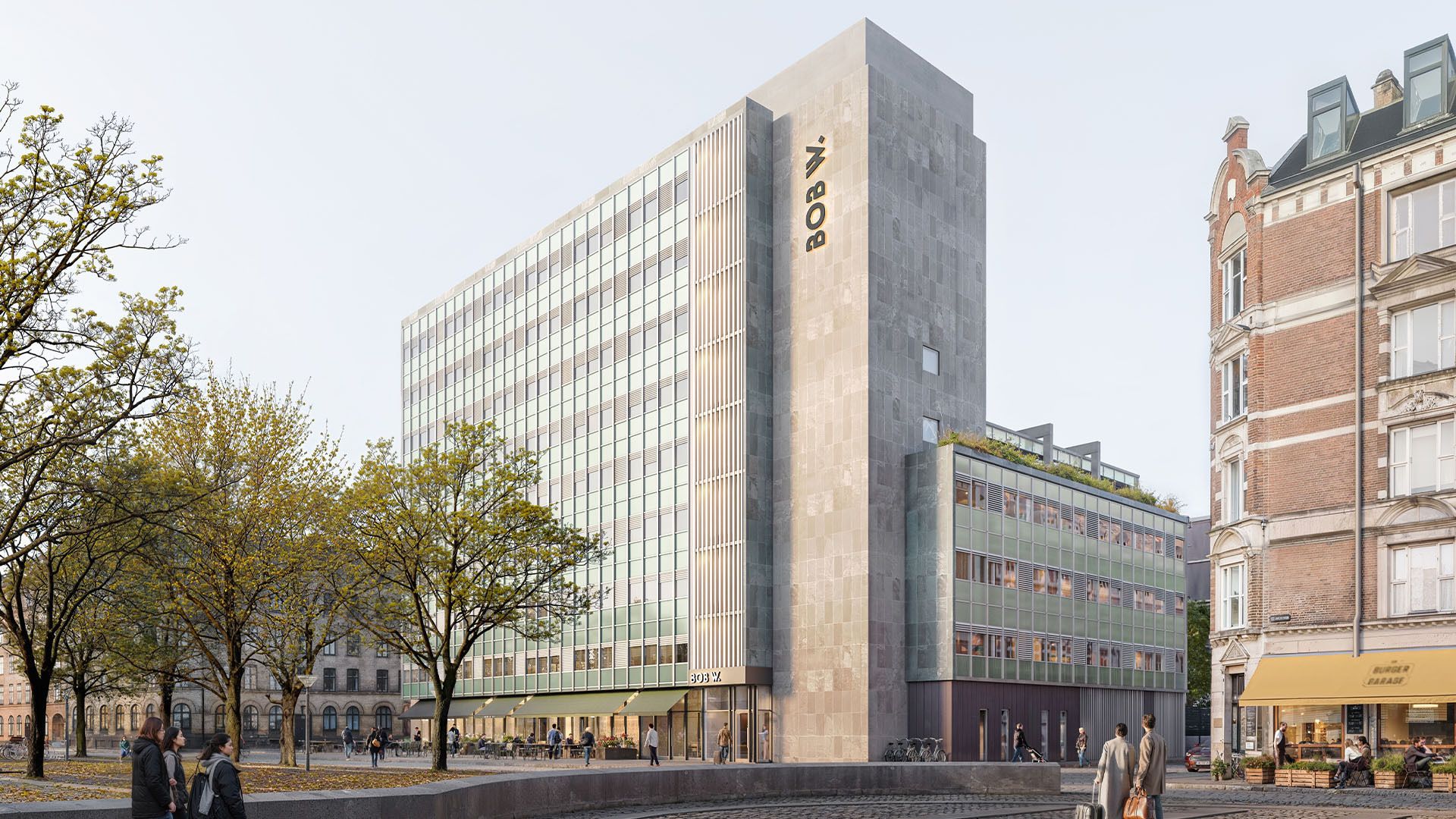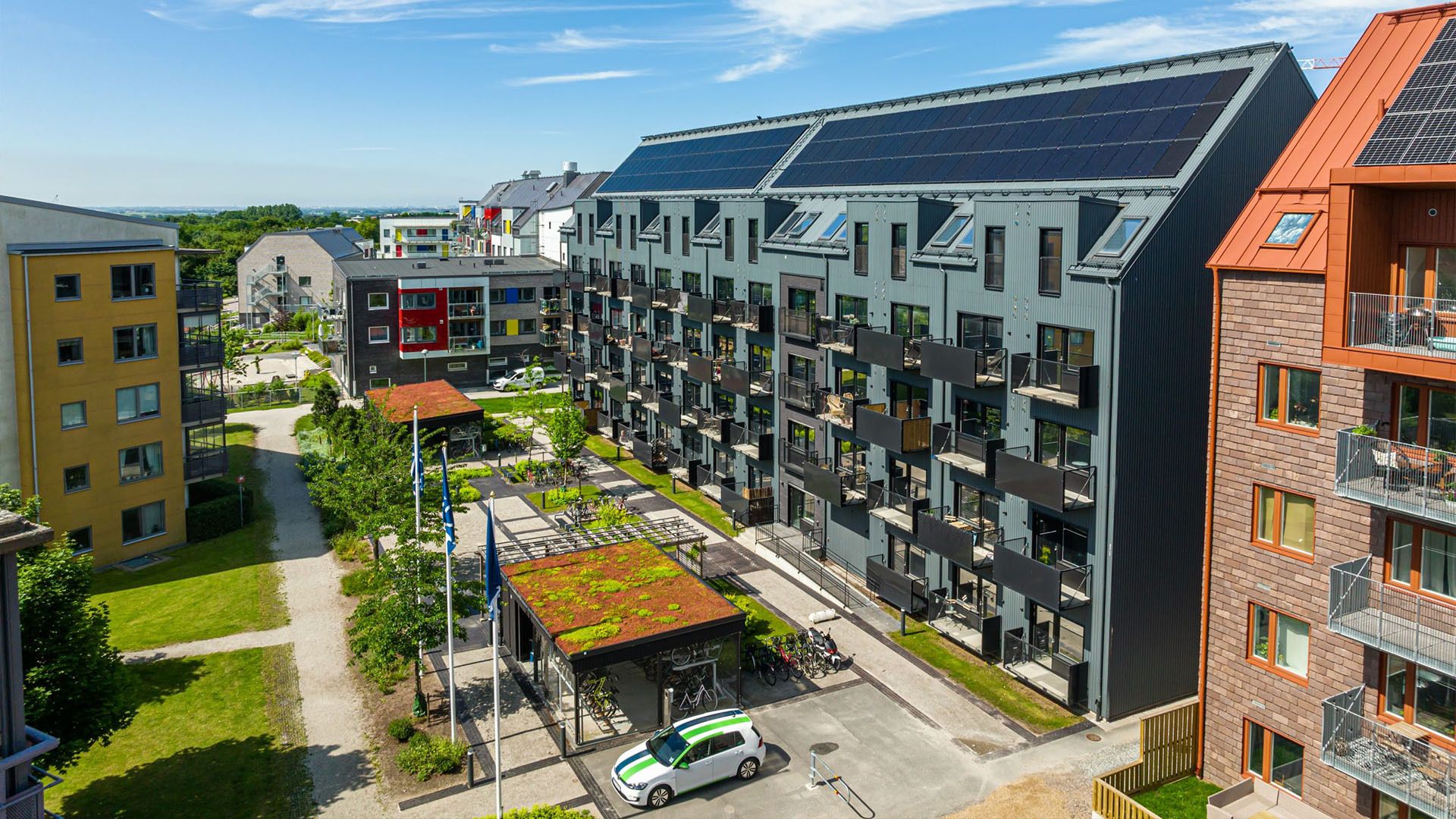 Credit: Markus Mainka | Adobe Stock
Credit: Markus Mainka | Adobe StockSlättö: Why the Nordic real estate market is poised for growth
How historic repricing, fundamentals, and stability are creating Europe's top investment window
October 9, 2025Real Estate
Written by:Helen Richards
Key Takeaways:
In the current global economic landscape, real estate investors are actively seeking markets that offer a compelling blend of stability, growth potential, and favourable entry timing. With more than EUR 3 billion AUM, real estate private equity firm, Slättö, argues that the present moment offers a particularly compelling timing to enter the Nordic market.

“The Nordics provide a safe haven as a very stable place in the world on a relative basis,” describes Jonas Andersson, Deputy Managing Partner at Slättö, during his exclusive interview at Europe GRI 2025. “It is the third largest transaction market in Europe, after the UK and Germany.”
This economic stability is also supported by a proven track record of innovation leadership, and exceptionally favourable current market dynamics, with Sweden and Finland being two of the quickest European markets to reprice, explains Jonas.
This economic fortitude translates directly into superior growth forecasts. According to estimates from SEB and the IMF, Nordic GDP is projected to grow by 2.0% in 2026, comfortably outpacing thfe Eurozone’s 1.3% and the OECD’s 1.5%. This growth premium is expected to continue through the 2026-2030 period.
Beyond finance, the Nordics are global pioneers, ranking highly in sustainability, digitalisation, and transparency, and consistently scoring at the top for political stability and business climate.
The region's demographic outlook further bolsters the long-term real estate case. The Nordic population is forecasted to grow by a substantial 9.7% by 2050, contrasting sharply with the near-zero growth (0.1%) anticipated for the rest of Europe. This growth is compounded by a powerful trend of urbanisation, with 92% of the Nordic population expected to live in urban centres, exceeding the 83% European average. This combination creates persistent demand for modern, centrally located real estate across major urban hubs.

A crucial development is that the market repricing is largely complete. Slättö concluded in late 2023 that the market had passed its trough and has since been one of the most active investors in the region, signaling confidence in current valuations. Yields are now generally stabilising or starting to compress, indicating a shift from a buyer’s to a potentially more balanced market.
While the overall Nordic picture is strong, the specific dynamics vary by country, offering different avenues for opportunistic investors.
The significant repricing in the Swedish market is complete. “We're seeing clear stabilisation, more transaction volume, and signs of compression in the market,” says Jonas. The market is active, with banks competing for volume and operational performance remaining strong. Slättö notes that overleverage among smaller real estate companies remains a factor, creating specific opportunities for agile local players who can transact swiftly and source proprietary deals.
Meanwhile, yields are now stabilising in the Finnish market, following a period of sharp repricing and constrained liquidity. While overall fundamentals are weaker, the Helsinki metropolitan area performs well.
Limited competition among buyers is presenting opportunities with high ingoing yields, though liquidity concerns persist. “50% of the transaction volume comes from international capital - typically Swedish investors or German funds - and those players aren’t active at this point in time, [causing] low liquidity,” explains Jonas.
“Denmark hasn’t repriced to the extent that Sweden and Finland have,” describes Jonas. Though the Danish market is “well -functioning”, it has experienced low transaction activity due to long-term fixed interest rate structures that limited repricing speed. Yields are now normalising with signs of compression. Operational performance is solid, but tighter yields mean Slättö maintains an opportunistic approach to sourcing deals.
The Norwegian market has also seen substantial repricing, with yields now stabilising. Fundamentals are sound, supported by a strong domestic investor base. Investors face tighter yields and high interest costs, but Norway’s position early in its interest rate cutting cycle suggests potential future relief and yield compression.
“Norway stands out in the sense that it is a very domestic [market],” says Jonas. “The cost of financing is also substantially higher compared to other parts of the Nordics [due to] higher interest rates. So, while we cover [the country] opportunistically, we see better opportunities in Sweden, Finland, and Denmark.”

The Nordic region has led the way in market recovery following one of Europe’s most substantial repricing events. This correction has driven prime yields to levels not seen in years, creating a critical mass of attractive valuations. Prime residential yields have seen significant expansion, specifically 1.50%, 2.10%, and 1.30% in Stockholm, Helsinki, and Copenhagen, respectively.
The crucial shift now is that yield compression is becoming evident, signalling that the market trough has passed and values are beginning to stabilise and increase. This is combined with strong underlying fundamentals that support growth ahead, locking in current attractive yields with future capital appreciation potential.
Simultaneously, transaction activity is picking up, which is a leading indicator of stronger growth and market confidence. This influx of activity is supported by financial institutions, as banks compete for volume in commercial real estate lending.
“We have a conviction towards residential,” says Jonas; the segment is a core component of Slättö's strategy. Sweden stands out due to its regulated rental system, which acts as a safe haven during turbulent times. The sector is characterised by strong interest from international investors (accounting for 33% of year-to-date activity) and currently offers yields at a ten-year high. Strong real rental growth is expected to persist.
In Finland, the housing market in the Helsinki region is experiencing a favourable structural shift. A growing population combined with a sharp decline in new construction is creating a supply/demand imbalance, pointing to a favourable outlook over a three to five-year horizon.
Denmark's Copenhagen market, while exhibiting tight yields, is positioned for rental growth driven by factors such as population growth, real salary increases, a historical supply backlog, and constrained new supply.
Meanwhile, the light industrial segment across the Nordics remains exceptionally stable. This stability is underpinned by strong tenant demand for high-quality premises and low vacancy rates.
A significant value-creation opportunity exists as a substantial share of the existing industrial stock is under-rented. This is partly due to the relentless pace of urbanisation, which sees former industrial areas being converted for alternative, often residential, uses, thus limiting the future supply of industrial space. Slättö is positioned to capitalise on this through active asset management and selective acquisitions that capture embedded value.
The hospitality sector is also showing positive development across the Nordics. Hotel occupancy and Revenue Per Available Room (RevPAR) are growing in major Nordic cities. Slättö is focusing on the rising demand for technology-driven aparthotels, which are proving particularly attractive. Investor sentiment in the overall sector is strong, with more funds allocating capital to hospitality. Pricing, particularly within the budget and aparthotel segments, has begun to stabilise, confirming the recovery and future potential of this segment.
ESG remains consistently high on the agenda for Nordic investors, and in response, Slättö has made it an integrated part of its underwriting process. “It’s a win-win,” illustrates Jonas. “The yield on cost of energy efficiency investments, regardless if it’s residential or light industrial, is quite appealing.”
The firm's core philosophy is that sustainability, when executed correctly, can actively enhance returns. This approach provides a tangible competitive advantage by cutting operating expenses and securing future cash flows, demonstrated in the following two examples:
The confluence of economic stability, favourable demographics, significant market repricing, and a commitment to ESG integration confirms Slättö's assertion: the Nordic real estate market isn't merely a safe port in a stormy European economy, it is a launchpad for superior returns.
As the region presents arguably one of the most attractive acquisition windows of the past decade, the time to move from analysis to action is now, before the recovery cycle fully matures and this unique pricing advantage fades.

- Substantial and completed repricing in the Nordic real estate market has driven yields to attractive levels, creating the best acquisition window in a decade.
- The region is a stable safe haven with robust economies, superior GDP growth, and a strong long-term outlook supported by a forecasted 9.7% population growth by 2050.
- Integrated ESG strategies enhance returns by cutting operating costs, while strong fundamentals in the Nordic residential and light industrial sectors drive significant portfolio value.
In the current global economic landscape, real estate investors are actively seeking markets that offer a compelling blend of stability, growth potential, and favourable entry timing. With more than EUR 3 billion AUM, real estate private equity firm, Slättö, argues that the present moment offers a particularly compelling timing to enter the Nordic market.

“The Nordics provide a safe haven as a very stable place in the world on a relative basis,” describes Jonas Andersson, Deputy Managing Partner at Slättö, during his exclusive interview at Europe GRI 2025. “It is the third largest transaction market in Europe, after the UK and Germany.”
This economic stability is also supported by a proven track record of innovation leadership, and exceptionally favourable current market dynamics, with Sweden and Finland being two of the quickest European markets to reprice, explains Jonas.
The Fundamentals
The underlying economies of the Nordic nations are robust and exhibit consistent strength. Key indicators include consistent GDP outperformance, solid public finances, and sustained population growth. This stability is further underscored by the fact that the Nordics boast three of the eight AAA-rated sovereigns in Europe, ensuring a secure financial backdrop. With a GDP per capita of approximately EUR 60,000, the region surpasses the average of major European economies.This economic fortitude translates directly into superior growth forecasts. According to estimates from SEB and the IMF, Nordic GDP is projected to grow by 2.0% in 2026, comfortably outpacing thfe Eurozone’s 1.3% and the OECD’s 1.5%. This growth premium is expected to continue through the 2026-2030 period.
Beyond finance, the Nordics are global pioneers, ranking highly in sustainability, digitalisation, and transparency, and consistently scoring at the top for political stability and business climate.
The region's demographic outlook further bolsters the long-term real estate case. The Nordic population is forecasted to grow by a substantial 9.7% by 2050, contrasting sharply with the near-zero growth (0.1%) anticipated for the rest of Europe. This growth is compounded by a powerful trend of urbanisation, with 92% of the Nordic population expected to live in urban centres, exceeding the 83% European average. This combination creates persistent demand for modern, centrally located real estate across major urban hubs.

Jonas Andersson, Deputy Managing Partner at Slättö, gave an exclusive interview during Europe GRI 2025. (Credit: Slättö)
The Real Estate Market
The Nordics constitute a large and liquid real estate market underpinned by strong fundamental growth. This market depth is evidenced by Cushman & Wakefield's projection of a substantial 25% transaction volume growth between 2024 and 2025. The region benefits from a diverse investor base, including local and international players, and is supported by a strong and prudent banking environment. The presence of a well-functioning bond market in key countries further aids liquidity and capital access.A crucial development is that the market repricing is largely complete. Slättö concluded in late 2023 that the market had passed its trough and has since been one of the most active investors in the region, signaling confidence in current valuations. Yields are now generally stabilising or starting to compress, indicating a shift from a buyer’s to a potentially more balanced market.
While the overall Nordic picture is strong, the specific dynamics vary by country, offering different avenues for opportunistic investors.
The significant repricing in the Swedish market is complete. “We're seeing clear stabilisation, more transaction volume, and signs of compression in the market,” says Jonas. The market is active, with banks competing for volume and operational performance remaining strong. Slättö notes that overleverage among smaller real estate companies remains a factor, creating specific opportunities for agile local players who can transact swiftly and source proprietary deals.
Meanwhile, yields are now stabilising in the Finnish market, following a period of sharp repricing and constrained liquidity. While overall fundamentals are weaker, the Helsinki metropolitan area performs well.
Limited competition among buyers is presenting opportunities with high ingoing yields, though liquidity concerns persist. “50% of the transaction volume comes from international capital - typically Swedish investors or German funds - and those players aren’t active at this point in time, [causing] low liquidity,” explains Jonas.
“Denmark hasn’t repriced to the extent that Sweden and Finland have,” describes Jonas. Though the Danish market is “well -functioning”, it has experienced low transaction activity due to long-term fixed interest rate structures that limited repricing speed. Yields are now normalising with signs of compression. Operational performance is solid, but tighter yields mean Slättö maintains an opportunistic approach to sourcing deals.
The Norwegian market has also seen substantial repricing, with yields now stabilising. Fundamentals are sound, supported by a strong domestic investor base. Investors face tighter yields and high interest costs, but Norway’s position early in its interest rate cutting cycle suggests potential future relief and yield compression.
“Norway stands out in the sense that it is a very domestic [market],” says Jonas. “The cost of financing is also substantially higher compared to other parts of the Nordics [due to] higher interest rates. So, while we cover [the country] opportunistically, we see better opportunities in Sweden, Finland, and Denmark.”

Halmtorvet 20-22, Copenhagen: Landmark office-to-hotel conversion marks Slättö’s growth in Denmark. (Credit: Slättö)
Why Now?
The current climate represents the best acquisition window in a decade for well-capitalised investors entering the Nordic real estate market. The narrative of "Why now?" is centered on the compelling combination of achieved market repricing, nascent yield compression, and accelerating transaction activity.The Nordic region has led the way in market recovery following one of Europe’s most substantial repricing events. This correction has driven prime yields to levels not seen in years, creating a critical mass of attractive valuations. Prime residential yields have seen significant expansion, specifically 1.50%, 2.10%, and 1.30% in Stockholm, Helsinki, and Copenhagen, respectively.
The crucial shift now is that yield compression is becoming evident, signalling that the market trough has passed and values are beginning to stabilise and increase. This is combined with strong underlying fundamentals that support growth ahead, locking in current attractive yields with future capital appreciation potential.
Simultaneously, transaction activity is picking up, which is a leading indicator of stronger growth and market confidence. This influx of activity is supported by financial institutions, as banks compete for volume in commercial real estate lending.
Slättö’s Portfolio
Slättö strategically manages a diversified real estate portfolio across the Nordic region, recognising that each sector and geography presents unique dynamics and opportunities within the current market environment.“We have a conviction towards residential,” says Jonas; the segment is a core component of Slättö's strategy. Sweden stands out due to its regulated rental system, which acts as a safe haven during turbulent times. The sector is characterised by strong interest from international investors (accounting for 33% of year-to-date activity) and currently offers yields at a ten-year high. Strong real rental growth is expected to persist.
In Finland, the housing market in the Helsinki region is experiencing a favourable structural shift. A growing population combined with a sharp decline in new construction is creating a supply/demand imbalance, pointing to a favourable outlook over a three to five-year horizon.
Denmark's Copenhagen market, while exhibiting tight yields, is positioned for rental growth driven by factors such as population growth, real salary increases, a historical supply backlog, and constrained new supply.
Meanwhile, the light industrial segment across the Nordics remains exceptionally stable. This stability is underpinned by strong tenant demand for high-quality premises and low vacancy rates.
A significant value-creation opportunity exists as a substantial share of the existing industrial stock is under-rented. This is partly due to the relentless pace of urbanisation, which sees former industrial areas being converted for alternative, often residential, uses, thus limiting the future supply of industrial space. Slättö is positioned to capitalise on this through active asset management and selective acquisitions that capture embedded value.
The hospitality sector is also showing positive development across the Nordics. Hotel occupancy and Revenue Per Available Room (RevPAR) are growing in major Nordic cities. Slättö is focusing on the rising demand for technology-driven aparthotels, which are proving particularly attractive. Investor sentiment in the overall sector is strong, with more funds allocating capital to hospitality. Pricing, particularly within the budget and aparthotel segments, has begun to stabilise, confirming the recovery and future potential of this segment.
ESG
For Slättö, environmental, social, and governance (ESG) considerations are not merely a compliance issue; they are a fundamental component of every investment strategy, reflecting both investor priorities and a crucial pathway to long-term value creation.ESG remains consistently high on the agenda for Nordic investors, and in response, Slättö has made it an integrated part of its underwriting process. “It’s a win-win,” illustrates Jonas. “The yield on cost of energy efficiency investments, regardless if it’s residential or light industrial, is quite appealing.”
The firm's core philosophy is that sustainability, when executed correctly, can actively enhance returns. This approach provides a tangible competitive advantage by cutting operating expenses and securing future cash flows, demonstrated in the following two examples:
- Energy Efficiency in Residential Assets: By focusing on energy efficiency measures, Slättö directly cuts operating costs. A recent pilot program involving heat optimisation in residential properties successfully demonstrated the potential to save 5-10% of heating costs, immediately boosting the net operating income of those assets.
- Solar Power in Logistics & Light Industrial (L&LI) Assets: In the light industrial sector, Slättö has invested in highly efficient installations and solar power. These improvements not only reduce the environmental footprint but also enhance the asset's appeal to tenants, allowing the firm to successfully negotiate rent increases that reflect the superior, lower-cost operating environment provided to the occupiers.
The confluence of economic stability, favourable demographics, significant market repricing, and a commitment to ESG integration confirms Slättö's assertion: the Nordic real estate market isn't merely a safe port in a stormy European economy, it is a launchpad for superior returns.
As the region presents arguably one of the most attractive acquisition windows of the past decade, the time to move from analysis to action is now, before the recovery cycle fully matures and this unique pricing advantage fades.

